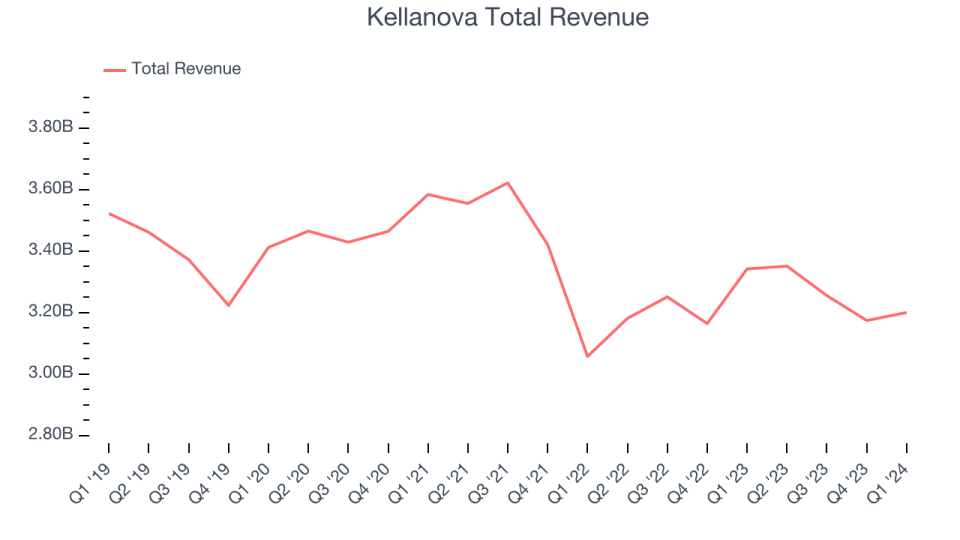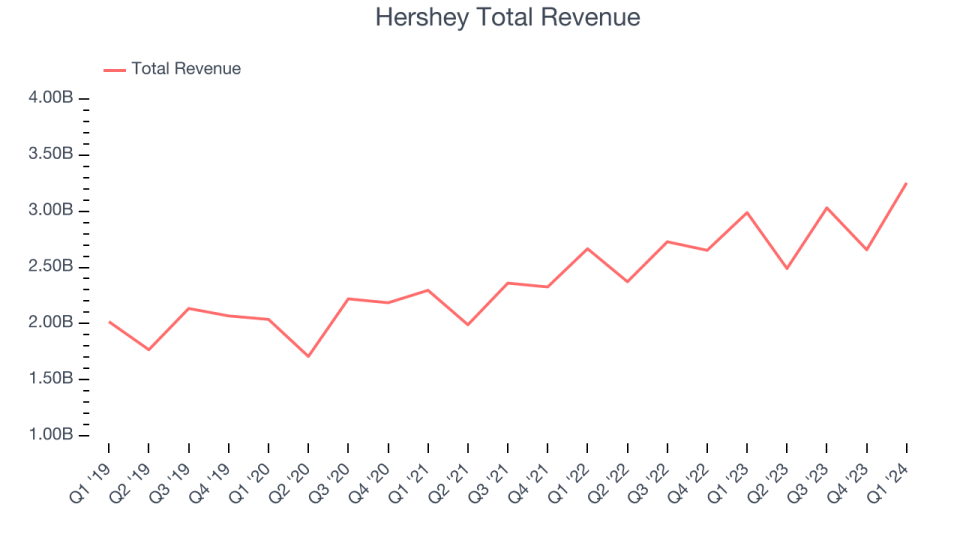Unpacking Q1 Earnings: Kellanova (NYSE:K) In The Context Of Other Shelf-Stable Food Stocks

Let's dig into the relative performance of Kellanova (NYSE:K) and its peers as we unravel the now-completed Q1 shelf-stable food earnings season.
As America industrialized and moved away from an agricultural economy, people faced more demands on their time. Packaged foods emerged as a solution offering convenience to the evolving American family, whether it be canned goods or snacks. Today, Americans seek brands that are high in quality, reliable, and reasonably priced. Furthermore, there's a growing emphasis on health-conscious and sustainable food options. Packaged food stocks are considered resilient investments. People always need to eat, so these companies can enjoy consistent demand as long as they stay on top of changing consumer preferences. The industry spans from multinational corporations to smaller specialized firms and is subject to food safety and labeling regulations.
The 21 shelf-stable food stocks we track reported a decent Q1; on average, revenues beat analyst consensus estimates by 0.5%. while next quarter's revenue guidance was 1.6% below consensus. Stocks--especially those trading at higher multiples--had a strong end of 2023, but 2024 has seen periods of volatility. Mixed signals about inflation have led to uncertainty around rate cuts, and while some of the shelf-stable food stocks have fared somewhat better than others, they collectively declined, with share prices falling 3% on average since the previous earnings results.
Kellanova (NYSE:K)
With Corn Flakes as its first and most iconic product, Kellanova (NYSE:K) is a packaged foods company that is dominant in the cereal and snack categories.
Kellanova reported revenues of $3.2 billion, down 4.2% year on year, topping analysts' expectations by 1.3%. It was a mixed quarter for the company, with an impressive beat of analysts' organic revenue growth estimates but a miss of analysts' gross margin estimates.

The stock is up 3.1% since the results and currently trades at $58.73.
Read our full report on Kellanova here, it's free.
Best Q1: Hershey (NYSE:HSY)
Best known for its milk chocolate bar and Hershey's Kisses, Hershey (NYSE:HSY) is an iconic company known for its chocolate products.
Hershey reported revenues of $3.25 billion, up 8.9% year on year, outperforming analysts' expectations by 4.5%. It was a stunning quarter for the company, with an impressive beat of analysts' gross margin and EPS estimates.

The stock is down 5.5% since the results and currently trades at $185.11.
Is now the time to buy Hershey? Access our full analysis of the earnings results here, it's free.
Weakest Q1: Lamb Weston (NYSE:LW)
Best known for its Grown in Idaho brand, Lamb Weston (NYSE:LW) produces and distributes potato products such as frozen french fries and mashed potatoes.
Lamb Weston reported revenues of $1.46 billion, up 16.3% year on year, falling short of analysts' expectations by 11.8%. It was a weak quarter for the company, with full-year revenue guidance missing analysts' expectations and a miss of analysts' operating margin estimates.
Lamb Weston had the weakest performance against analyst estimates and weakest full-year guidance update in the group. The stock is down 14% since the results and currently trades at $86.95.
Read our full analysis of Lamb Weston's results here.
Post (NYSE:POST)
Founded in 1895, Post (NYSE:POST) is a packaged food company known for its namesake breakfast cereal and healthier-for-you snacks.
Post reported revenues of $2.00 billion, up 23.4% year on year, falling short of analysts' expectations by 1.5%. It was a solid quarter for the company, with an impressive beat of analysts' gross margin estimates and a decent beat of analysts' earnings estimates.
The stock is down 3.8% since the results and currently trades at $100.86.
Read our full, actionable report on Post here, it's free.
Campbell Soup (NYSE:CPB)
With its iconic canned soup as its cornerstone product, Campbell Soup (NASDAQ:CPB) is a packaged food company with an illustrious portfolio of brands.
Campbell Soup reported revenues of $2.37 billion, up 6.3% year on year, in line with analysts' expectations. It was an ok quarter for the company, with an impressive beat of analysts' organic revenue growth estimates but a miss of analysts' operating margin estimates.
The stock is down 2.6% since the results and currently trades at $43.09.
Read our full, actionable report on Campbell Soup here, it's free.
Join Paid Stock Investor Research
Help us make StockStory more helpful to investors like yourself. Join our paid user research session and receive a $50 Amazon gift card for your opinions. Sign up here.

 Yahoo Finance
Yahoo Finance 